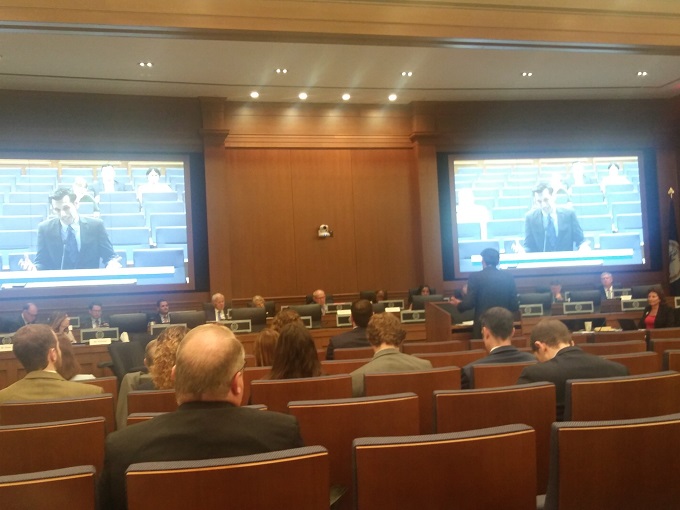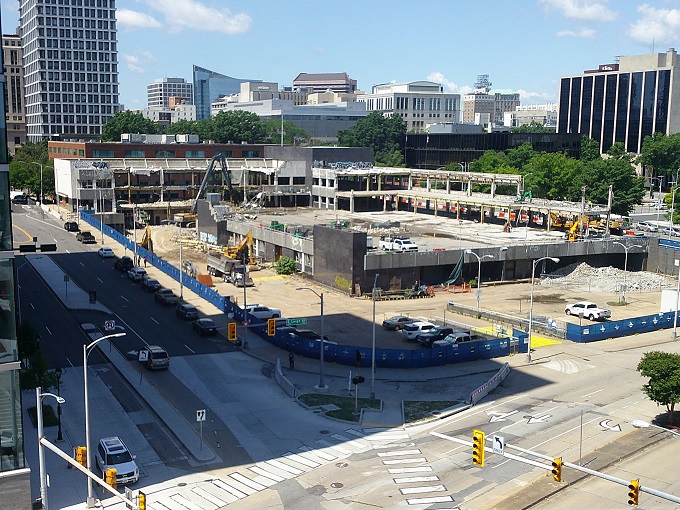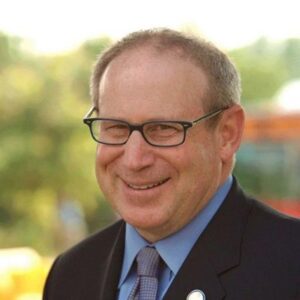A year after a Richmond BizSense report revealed that backing out of an ill-fated downtown development cost VCU Health $80 million and counting, a state review is calling for significant changes to the health system’s leadership structure.
At a meeting Wednesday of the Joint Legislative Audit & Review Commission, the oversight agency of the Virginia General Assembly, JLARC staff presented the findings and recommendations from a monthslong study of VCU Health aimed at improving the health system’s governance and process for reviewing and approving capital projects.
The recommendations include eliminating the VCU Health president position currently held by Virginia Commonwealth University President Michael Rao, and changing state law to limit the university president’s role on the health system board, which Rao leads as chairman in accordance with VCU Health’s bylaws.
JLARC also recommends that VCU Health retain its “authority” structure and remain separate from the university, going counter to the findings of a consultant hired by VCU and VCU Health that suggested the health system become a subsidiary of the university.
Other recommendations include development of a 10-year strategic capital plan for the health system, addition of director-level positions overseeing construction and real estate functions, policy changes requiring use of outside experts on high-dollar or high-risk projects, and creation of a joint committee of the VCU and VCU Health boards to ensure effective communication and collaboration between the two legally separate but related agencies.
The review, which JLARC OK’d in November, stemmed from what is known as the “Clay Street project.” The aborted redevelopment of Richmond’s old Public Safety Building ended with VCU Health paying $73 million to back out of its lease, along with additional costs that continue to add up.
While the review did not focus on the multibuilding high-rise office complex, it found that the project “highlighted shortcomings” in VCU Health’s capital projects review process and “raised questions” about influence from university leadership over health system decisions.
The review also found that VCU Health “lacks sufficient leadership and staff capacity in key functions related to capital projects” and “has relied on VCU staff to fill staffing gaps.” It additionally described Rao’s roles as health system president and board chairman as having “enabled VCU to have too much influence over” VCU Health.
Rao, who attended and spoke at Wednesday’s meeting, reiterated his previous statements supporting changes to the VCU Health president and board chair positions. JLARC’s recommendations include making the university president a nonvoting member of the health system board, ineligible to serve as chair.
Addressing the state senators and delegates who make up the commission, Rao said after Wednesday’s presentation: “I don’t know of anyone else who serves as the university’s president and the health system’s president at the same time.” Noting the bylaws make them a coordinated role, Rao added: “It is a confusing thing to have out there, in my opinion.”
Rao also addressed the Clay Street project and the $80 million in costs resulting from the exit. Those include $5 million for demolition currently underway of the city-owned site and annual “guaranteed obligation” payments that VCU Health committed to pay the City of Richmond to cover the minimum real estate tax revenue that the $325 million development was anticipated to generate over 25 years.
Describing the exit as a difficult but prudent decision that saved the health system from future financial liabilities, Rao told the commission, “We all regret that the result wasn’t what anyone wanted, but I will say that the buck stops with me as chair of the health system board of directors.”
‘I believed that any concerns that existed had been resolved’

VCU President Michael Rao addresses the commission following Wednesday’s presentation. (Jonathan Spiers photos)
Rao told the commission that the health system had desired the Public Safety Building site for years because of its proximity to its MCV Campus. He said he believed that concerns raised about the proposed project in 2021 were legitimate and asked the then-acting VCU Health CEO to work with university leadership because of vacancies in the health system’s team from the departures of its chief financial officer and chief legal counsel.
“I also asked – and I was 5,000 miles away, by the way – that the chair of the health system board of directors’ finance committee be involved, and along with other board members I suggested that others be involved,” Rao said. “When it was reported back to me, however, that the meetings went well and the agreement had been signed, I believed that any concerns that existed had been resolved.”
Rao was referring to then-CEO Art Kellermann, who fought for Rao and others to reconsider the deal before ultimately signing off on it at the urging of university leadership. Rao had been traveling internationally during a critical email exchange with Kellermann.
Three months later, the developers informed the health system that the original project couldn’t be built, citing challenges with the site that were driving up costs and increases in construction costs fueled by the pandemic and inflation. A scaled-down version of the project was offered, but ultimately the project could not be saved as talks turned to how to get out of it – leading to the $73 million defeasance payment.
Around that time, Kellermann was out, resigning at Rao’s request for reasons that remain undisclosed.
One of JLARC’s recommendations involves amending state law to remove language giving the VCU president authority to decide on “the selection, removal, or conditions of appointment (including salary) of the VCU Health CEO” when committees appointed by the health system board cannot reach agreement.
It also recommends separating the CEO role from the VCU senior vice president of health sciences role that were jointly held by Kellermann and are now by VCU Health interim CEO Marlon Levy. That would result in two positions that JLARC recommends be required by state law “to regularly communicate and collaborate to support the mutual interests and success” of the health system and VCU.
Rao maintained Wednesday that the health system board decided to exit the Clay Street project in light of challenges arising over the course of the pandemic and the financial obligations that came with the deal, including $617 million in rent over the 25-year lease.
“We all knew at that time that it was a very difficult decision, and this was a discussion that occurred over many, many meetings with many, many people,” Rao told the commission. “It was also the right decision because it avoided far greater future financial liabilities, including what we had been advised could be a likely downgrade of the health system’s bond ratings.”
Rao said many of JLARC’s recommendations already have begun to be implemented. Those include, he said, strengthening its capital plan, creating a “significant transaction” policy and board engagement process, retaining third-party advisers for high-profile or high-dollar transactions, and establishing project management teams and stronger project due diligence.
“Today’s report reinforces much of the previously released information, and many of the JLARC staff’s recommendations were implemented last year,” Rao said.
He added that some of the recommendations would require “deep consideration and discussion” by both boards about “how these recommendations could fundamentally affect the relationship between the health system and the university.”
“I believe both boards are interested in that and see that value,” he said. “I anticipate that both boards will begin pretty deep dialogue very soon, now that the report is public.”
‘Did a lawyer look at this?’

Demolition of the old Public Safety Building at Leigh and 10th streets has been underway for months, with VCU Health footing the $5 million bill.
Rao faced a brief series of questions from commissioners, who scrutinized the financial commitments the health system made and questioned the legality of the guaranteed obligation payments, referred to in the meeting as payments in lieu of taxes.
Legislators have ordered VCU Health to find a way to stop making the payments, the latest of which – $2 million for the 2024 tax year – just so happened to be due the same day as JLARC’s meeting.
If paid out completely, the 25 annual payments would total nearly $56 million paid to the city.
“There was an $80 million payment to get out of this deal, and there’s still an in-lieu-of-tax payment. I don’t think there’s ever been a contract like that for a public entity,” said Sen. Creigh Deeds, who was among those who included the directive in the state budget.
Del. Mark Sickles, JLARC’s chairman, asked Rao: “Did a lawyer look at this and sign off on the payment in lieu of taxes?” To which Rao replied: “There are attorneys involved now.”
Levy, VCU Health’s interim CEO, added that the payments agreement was reviewed by both internal and external legal counsel. On the legality question, Levy said, “That’s currently under review.”
“So somebody thinks it’s legal, or you wouldn’t have entered into it,” Sickles said.
“At the time that this was agreed to, it was felt to be correct to do that,” Levy answered. “In the present tense, that’s being reviewed and why we’re currently in conversations with the city about that very topic.”
The $2 million payment due Wednesday had not yet been paid, a VCU Health System spokesman confirmed after the meeting.
“We do not expect to make the payment today and continue to be in regular conversations with the City about this,” spokesman Grant Heston said in an email.
“We are fully committed to reaching a mutually agreeable solution.”
The City of Richmond also provided a statement Wednesday, telling BizSense that it “believes the guaranteed obligation agreed to by (VCU Health) needs to be honored. It is a contractual requirement entered into by (VCU Health) of their own volition.”
Lincoln Saunders, Richmond’s chief administrative officer, attended Wednesday’s JLARC meeting.
The full JLARC presentation can be viewed on the agency’s website. It was led by Chief Legal Analyst Lauren Axselle and involved interviews with VCU Health and VCU leadership and current and former board members, reviews of selected capital projects and relevant governance documents, and reviews of other health systems.
Teeing up Axselle’s presentation, JLARC Director Hal Greer told the commission that “the unraveling of VCU Health’s lease” for the Clay Street project prompted calls for the review, which did not involve a formal report but rather the presentation exceeding 100 slides.
“The information we’re presenting on the project has generally already been reported on by the media, and we won’t dwell on what happened with Clay Street this morning,” Greer said. Noting that the project informs some of the recommendations, he added: “The report instead focuses on findings and recommendations to improve VCU Health’s capital process and governance structure going forward.”
At the close of her presentation, Axselle said all the recommendations “are things we strongly feel will help the health system, especially as it works toward renovating its downtown medical center campus.”
“Looking forward,” she added, “that effort will involve a lot of capital projects and the need for leadership to make important decisions on behalf of the health system.”
A year after a Richmond BizSense report revealed that backing out of an ill-fated downtown development cost VCU Health $80 million and counting, a state review is calling for significant changes to the health system’s leadership structure.
At a meeting Wednesday of the Joint Legislative Audit & Review Commission, the oversight agency of the Virginia General Assembly, JLARC staff presented the findings and recommendations from a monthslong study of VCU Health aimed at improving the health system’s governance and process for reviewing and approving capital projects.
The recommendations include eliminating the VCU Health president position currently held by Virginia Commonwealth University President Michael Rao, and changing state law to limit the university president’s role on the health system board, which Rao leads as chairman in accordance with VCU Health’s bylaws.
JLARC also recommends that VCU Health retain its “authority” structure and remain separate from the university, going counter to the findings of a consultant hired by VCU and VCU Health that suggested the health system become a subsidiary of the university.
Other recommendations include development of a 10-year strategic capital plan for the health system, addition of director-level positions overseeing construction and real estate functions, policy changes requiring use of outside experts on high-dollar or high-risk projects, and creation of a joint committee of the VCU and VCU Health boards to ensure effective communication and collaboration between the two legally separate but related agencies.
The review, which JLARC OK’d in November, stemmed from what is known as the “Clay Street project.” The aborted redevelopment of Richmond’s old Public Safety Building ended with VCU Health paying $73 million to back out of its lease, along with additional costs that continue to add up.
While the review did not focus on the multibuilding high-rise office complex, it found that the project “highlighted shortcomings” in VCU Health’s capital projects review process and “raised questions” about influence from university leadership over health system decisions.
The review also found that VCU Health “lacks sufficient leadership and staff capacity in key functions related to capital projects” and “has relied on VCU staff to fill staffing gaps.” It additionally described Rao’s roles as health system president and board chairman as having “enabled VCU to have too much influence over” VCU Health.
Rao, who attended and spoke at Wednesday’s meeting, reiterated his previous statements supporting changes to the VCU Health president and board chair positions. JLARC’s recommendations include making the university president a nonvoting member of the health system board, ineligible to serve as chair.
Addressing the state senators and delegates who make up the commission, Rao said after Wednesday’s presentation: “I don’t know of anyone else who serves as the university’s president and the health system’s president at the same time.” Noting the bylaws make them a coordinated role, Rao added: “It is a confusing thing to have out there, in my opinion.”
Rao also addressed the Clay Street project and the $80 million in costs resulting from the exit. Those include $5 million for demolition currently underway of the city-owned site and annual “guaranteed obligation” payments that VCU Health committed to pay the City of Richmond to cover the minimum real estate tax revenue that the $325 million development was anticipated to generate over 25 years.
Describing the exit as a difficult but prudent decision that saved the health system from future financial liabilities, Rao told the commission, “We all regret that the result wasn’t what anyone wanted, but I will say that the buck stops with me as chair of the health system board of directors.”
‘I believed that any concerns that existed had been resolved’

VCU President Michael Rao addresses the commission following Wednesday’s presentation. (Jonathan Spiers photos)
Rao told the commission that the health system had desired the Public Safety Building site for years because of its proximity to its MCV Campus. He said he believed that concerns raised about the proposed project in 2021 were legitimate and asked the then-acting VCU Health CEO to work with university leadership because of vacancies in the health system’s team from the departures of its chief financial officer and chief legal counsel.
“I also asked – and I was 5,000 miles away, by the way – that the chair of the health system board of directors’ finance committee be involved, and along with other board members I suggested that others be involved,” Rao said. “When it was reported back to me, however, that the meetings went well and the agreement had been signed, I believed that any concerns that existed had been resolved.”
Rao was referring to then-CEO Art Kellermann, who fought for Rao and others to reconsider the deal before ultimately signing off on it at the urging of university leadership. Rao had been traveling internationally during a critical email exchange with Kellermann.
Three months later, the developers informed the health system that the original project couldn’t be built, citing challenges with the site that were driving up costs and increases in construction costs fueled by the pandemic and inflation. A scaled-down version of the project was offered, but ultimately the project could not be saved as talks turned to how to get out of it – leading to the $73 million defeasance payment.
Around that time, Kellermann was out, resigning at Rao’s request for reasons that remain undisclosed.
One of JLARC’s recommendations involves amending state law to remove language giving the VCU president authority to decide on “the selection, removal, or conditions of appointment (including salary) of the VCU Health CEO” when committees appointed by the health system board cannot reach agreement.
It also recommends separating the CEO role from the VCU senior vice president of health sciences role that were jointly held by Kellermann and are now by VCU Health interim CEO Marlon Levy. That would result in two positions that JLARC recommends be required by state law “to regularly communicate and collaborate to support the mutual interests and success” of the health system and VCU.
Rao maintained Wednesday that the health system board decided to exit the Clay Street project in light of challenges arising over the course of the pandemic and the financial obligations that came with the deal, including $617 million in rent over the 25-year lease.
“We all knew at that time that it was a very difficult decision, and this was a discussion that occurred over many, many meetings with many, many people,” Rao told the commission. “It was also the right decision because it avoided far greater future financial liabilities, including what we had been advised could be a likely downgrade of the health system’s bond ratings.”
Rao said many of JLARC’s recommendations already have begun to be implemented. Those include, he said, strengthening its capital plan, creating a “significant transaction” policy and board engagement process, retaining third-party advisers for high-profile or high-dollar transactions, and establishing project management teams and stronger project due diligence.
“Today’s report reinforces much of the previously released information, and many of the JLARC staff’s recommendations were implemented last year,” Rao said.
He added that some of the recommendations would require “deep consideration and discussion” by both boards about “how these recommendations could fundamentally affect the relationship between the health system and the university.”
“I believe both boards are interested in that and see that value,” he said. “I anticipate that both boards will begin pretty deep dialogue very soon, now that the report is public.”
‘Did a lawyer look at this?’

Demolition of the old Public Safety Building at Leigh and 10th streets has been underway for months, with VCU Health footing the $5 million bill.
Rao faced a brief series of questions from commissioners, who scrutinized the financial commitments the health system made and questioned the legality of the guaranteed obligation payments, referred to in the meeting as payments in lieu of taxes.
Legislators have ordered VCU Health to find a way to stop making the payments, the latest of which – $2 million for the 2024 tax year – just so happened to be due the same day as JLARC’s meeting.
If paid out completely, the 25 annual payments would total nearly $56 million paid to the city.
“There was an $80 million payment to get out of this deal, and there’s still an in-lieu-of-tax payment. I don’t think there’s ever been a contract like that for a public entity,” said Sen. Creigh Deeds, who was among those who included the directive in the state budget.
Del. Mark Sickles, JLARC’s chairman, asked Rao: “Did a lawyer look at this and sign off on the payment in lieu of taxes?” To which Rao replied: “There are attorneys involved now.”
Levy, VCU Health’s interim CEO, added that the payments agreement was reviewed by both internal and external legal counsel. On the legality question, Levy said, “That’s currently under review.”
“So somebody thinks it’s legal, or you wouldn’t have entered into it,” Sickles said.
“At the time that this was agreed to, it was felt to be correct to do that,” Levy answered. “In the present tense, that’s being reviewed and why we’re currently in conversations with the city about that very topic.”
The $2 million payment due Wednesday had not yet been paid, a VCU Health System spokesman confirmed after the meeting.
“We do not expect to make the payment today and continue to be in regular conversations with the City about this,” spokesman Grant Heston said in an email.
“We are fully committed to reaching a mutually agreeable solution.”
The City of Richmond also provided a statement Wednesday, telling BizSense that it “believes the guaranteed obligation agreed to by (VCU Health) needs to be honored. It is a contractual requirement entered into by (VCU Health) of their own volition.”
Lincoln Saunders, Richmond’s chief administrative officer, attended Wednesday’s JLARC meeting.
The full JLARC presentation can be viewed on the agency’s website. It was led by Chief Legal Analyst Lauren Axselle and involved interviews with VCU Health and VCU leadership and current and former board members, reviews of selected capital projects and relevant governance documents, and reviews of other health systems.
Teeing up Axselle’s presentation, JLARC Director Hal Greer told the commission that “the unraveling of VCU Health’s lease” for the Clay Street project prompted calls for the review, which did not involve a formal report but rather the presentation exceeding 100 slides.
“The information we’re presenting on the project has generally already been reported on by the media, and we won’t dwell on what happened with Clay Street this morning,” Greer said. Noting that the project informs some of the recommendations, he added: “The report instead focuses on findings and recommendations to improve VCU Health’s capital process and governance structure going forward.”
At the close of her presentation, Axselle said all the recommendations “are things we strongly feel will help the health system, especially as it works toward renovating its downtown medical center campus.”
“Looking forward,” she added, “that effort will involve a lot of capital projects and the need for leadership to make important decisions on behalf of the health system.”






I have yet to see an explanation of how VCU Health could possibly have owed the lenders $73M for the small amount of the loan that was actually drawn down by the owner and for such a short time. If the loan agreement required that payment for backing out of the deal, why would that not be an unenforceable penalty? And wouldn’t it be malpractice by a lawyer to have approved an agreement like that?
Joel, its called the “hind tit”.
We live in an age where someone can ‘lose” $80M of public money and still confidently keep their job, let alone avoid prosecution or jail time.
AI tells me that VCU Health could mint 500 new doctors with that money.
People should be losing their jobs over this.
People are fired for much less every day and for legally justified reasons. The decision making admitted in this article shows an absolute failure to lead. you are 5,000 miles away but can’t communicate? A 13 year old can maintain a snap chat account via proxies while away at summer camp with no cellular access, and you are telling me that the President of both a university and a health system has no access to email, Skype, text or hotel phone while traveling internationally in 2021? So they just needed to “believe” that concerns were resolved without verifying them? What’s… Read more »
This is a massive fraud and the entire process and the people involved need to be investigated for ill gotten gains, omission and organized crime, frankly. It’s a disgrace. One needs to only look at the people who work at the City, VCU and the law firms who represented all parties.